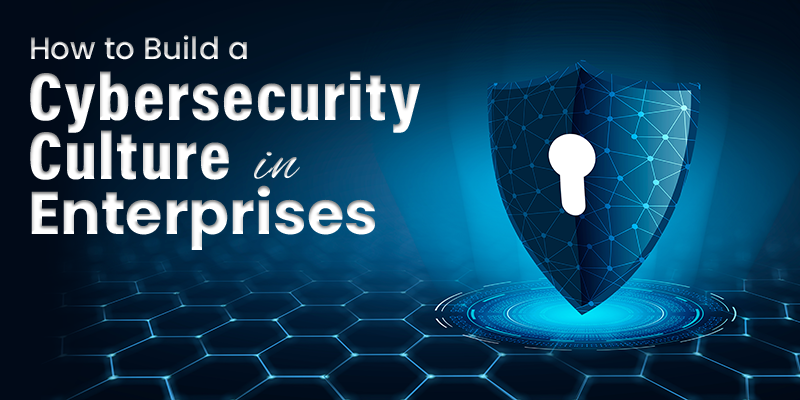How to Build a Cybersecurity Culture in Enterprises

Businesses are experiencing huge numbers of cyber threats and these numbers are expected to increase in the future as technological changes are happening rapidly. As new sets of sophisticated cyberattacks are evolving, enterprises should develop a business security plan that ensures data protection and privacy. Antivirus software and firewalls are not enough to deal with the kind of data breaches occurring in the virtual space. Hence, investing in cybersecurity training to build a cybersecurity culture is useful for the organization.
Healthy and strong cybersecurity culture is the key to keeping the digital assets of the organization secure. Enterprises that are dependent on the cybersecurity team will ensure that cybersecurity policies and procedures are in place. The cybersecurity team including CISO (Chief Information Security Officer) develops a security policy for the enterprise and creates security strategies based on the resources available and the risks involved. Building a cybersecurity culture is all about reorganizing the cybersecurity responsibilities to the people in the organization.
Good cybersecurity culture and upskilling the cybersecurity professionals are excellent deterrents to maintaining a robust ad effective cybersecurity posture in the organization.
Challenges to Create a Cybersecurity Culture
Enterprises are facing several challenges in creating and sustaining a cybersecurity culture. Some of the challenges faced by enterprises are:
- Lack of executive leadership or the CISO lacks the right skills to build a cybersecurity culture
- Dearth of a systematic approach to achieving the defined cybersecurity goals
- Lack of clear-cut cybersecurity policies
Tips to develop a cybersecurity culture
Invest in Right Security Tools
Equip the cybersecurity team with the right security tools to detect threats and enhance the defensive capabilities of the enterprise. Using several security tools or solutions with their own interface will complicate security management and administration. The number of security alerts received also will increase with the increase in the number of tools.
The enterprises must evaluate the security tools suitable for the organization. Organizations can develop a removal or consolidation strategy for the tools that are not effective. To reduce the functional gaps, enterprises can consolidate different tools.
Organizations can invest in SIEM solutions employing machine learning techniques, which will improve the detection and response to cyberthreats. The advent of SASE (Secure Access Service Edge) architecture and other frameworks enables enterprises to merge networking and security solutions in cloud architecture to ensure better protection and management.
Develop Security Talents
Based on the State of Security Report 2022, there is a huge increase in the cyberattacks that impacted the enterprises adversely, but security talents are scarce in organizations leaving the security teams to get exhausted.
Security teams should focus on the protection of the organization’s IT infrastructure, defend the external or internal threats, and maintain data confidentiality, availability, and integrity. Developing security talents refers to the efforts put on to upskill the employees that help to accomplish organizational goals.
As technologies are evolving, cyber attacks also increase and there will be a dire shortage of cybersecurity talents. Hence, it is important to train, recruit, and retain cybersecurity talents from different backgrounds.
Create a Succession Plan for the CISO
The role of CISO is evolving rapidly and more responsibilities must be carried out by the security executives, especially in large enterprises. Still, a well-defined path is described for the CISO or other security leaders. Many enterprises are not seriously considering the succession plan for the CISO. Creating a succession plan for the CISO is vital for the organization by recruiting security experts and upskilling security leaders to take up the role in the future.
To execute the succession plan, organizations can cultivate relationships with universities and EdTech academies to inculcate specific skills required for cybersecurity leadership.
Practice a Zero-Trust Policy
According to a research report by Market Research Future (MRFR), the zero-trust security market is worth US $32.15 billion at a CAGR of 15.4% by 2025.
Zero trust security is a framework for users, no matter whether they are inside or outside the organizational network, to get authorized and validated based on the security policy before accessing the organizational data and applications. Zero-trust policy is used for securing the infrastructure of the enterprise according to the modern-day digital transformation requirements.
Practicing a zero-trust framework by combining advanced technologies such as identity protection, next-gen endpoint security, multi-factor authentication, and robust cloud technology authorize the identity of users or systems to access organizational data.
Conclusion
A comprehensive cybersecurity culture involves every person in the enterprise, including top management to bottom-level employees, and every employee is responsible for following the cybersecurity practices. Building a healthy, safe, and positive cybersecurity culture in an organization is possible only by empowering the employees and upskilling security teams.



